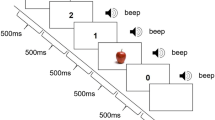Abstract
The Frequency (high vs. low) × Regularity (regular vs. exception) interaction found on naming response times is often taken as evidence for parallel processing of sub-lexical and lexical systems. Using a Go/No-go naming task, we investigated the effect of nonword versus pseudohomophone foils on sub-lexical processing and the subsequent Frequency × Regularity interaction. We ran two experiments: (1) a Go/No-go naming task with nonword foils (e.g., bint) and (2) a Go/No-go naming task with pseudohomophone foils (e.g., pynt). Experiment 1 replicated the Frequency × Regularity interaction on naming response times supporting the notion of parallel sub-lexical and lexical processing. Experiment 2 eliminated the Frequency × Regularity interaction providing evidence for the modulation of sub-lexical information. These results indicate that using pseudohomophones in the Go/No-go naming task minimized information provided from sub-lexical processing and maximized information provided from the lexical system.
Similar content being viewed by others
REferences
Balota D. A., Yap M. J., Cortese M. J., Hutchison K. A., Kessler B., Loftis B. et al (2007) The English lexicon project. Behavior Research Methods 39: 445–459
Besner D., O-Malley S., & Robidoux S. (2010) On the joint effects of stimulus quality, regularity and lexicality when reading aloud: New challenges. Journal of Experimental Psychology: Learning, Memory, and Cognition 36: 750–764
Besner D., Smith M. C. (1992) Models of visual word recognition: When obscuring the stimulus yields a clearer view. Journal of Experimental Psychology: Learning, Memory, and Cognition 18: 468–482
Borowsky R., Besner D. (1993) Visual word recognition: A multistage activation model. Journal of Experimental Psychology: Learning, Memory, and Cognition 19: 813–840
Braun M., Hutzler F., Ziegler J. C., Dambacher M., Jacobs A. M. (2009) Pseudohomophone effects provide evidence of early lexico-phonological processing in visual word recognition. Human Brain Mapping 30: 1977–1989
Coltheart M. et al (2001) DRC: A dual route cascaded model of visual word recognition and reading aloud. Psychological Review 108: 204–256
Ferguson R., Robidoux S., Besner D. (2009) Reading aloud: Evidence for contextual control over lexical activation. Journal of Experimental Psychology: Human Perception and Performance 35: 499–507
Hino Y., Lupker S. J. (2000) Effects of word frequency and spelling-to-sound regularity in naming with and without preceding lexical decision. Journal of Experimental Psychology: Human Perception and Performance 26: 166–183
Hino Y., Lupker S. J. (1998) The effects of word frequency for Japanese Kana and Kanji words in naming and lexical decision: Can the dual-route model save the lexical-selection account?. Journal of Experimental Psychology: Human Perception and Performance 24: 1431–1453
Kinoshita S., Lupker S. J., Rastle K. (2004) Modulation of regularity and lexicality effects in reading aloud. Memory & Cognition 32: 1255–1264
Lupker S. J., Brown P., Colombo L. (1997) Strategic control in a naming task: Changing routes or changing deadlines?. Journal of Experimental Psychology: Learning, Memory, and Cognition 23: 570–590
Monsell S., Patterson K. E., Graham A., Hughes C. H., Milroy R. (1992) Lexical and sublexical translation of spelling to sound: Strategic anticipation of lexical status. Journal of Experimental Psychology: Learning, Memory, and Cognition 18: 452–467
Olijnik S., Algina J. (2003) Generalized eta and omega squared statistics: Measures of effect size for some common research designs. Psychological Methods 8: 434–447
O’Malley S., Besner D. (2008) Reading aloud: Qualitative differences in the relation between stimulus quality and word frequency as a function of context. Journal of Experimental Psychology: Learning, Memory, and Cognition 34: 1400–1411
Paap K. R., Noel R. W. (1991) Dual-route models of print to sound: Still a good horse race. Psychological Research 53: 13–24
Simmonds D. J., Pekar J. J., Mostofsky S. H. (2008) Meta-analysis of Go/No-go tasks demonstrating that fMRI activation associated with response inhibition is task-dependent. Neuropsychologia 46: 224–232
Stolz J. A., Neely J. H. (1995) When target degradation does and does not enhance semantic context effects in word recognition. Journal of Experimental Psychology: Learning, Memory, and Cognition 21: 596–611
Visser T. A. W., Besner D. (2001) On the dominance of whole-word knowledge in reading aloud. Psychonomic Bulletin & Review 8: 560–567
Author information
Authors and Affiliations
Corresponding author
Rights and permissions
About this article
Cite this article
Cummine, J., Amyotte, J., Pancheshen, B. et al. Evidence for the Modulation of Sub-Lexical Processing in Go No-Go Naming: The Elimination of the Frequency × Regularity Interaction. J Psycholinguist Res 40, 367 (2011). https://doi.org/10.1007/s10936-011-9174-2
Published:
DOI: https://doi.org/10.1007/s10936-011-9174-2




